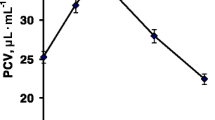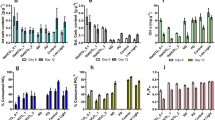Abstract
Carbon metabolism in photosynthesizing and respiring cells of Botryococcus braunii was radically changed by the presence of 1 mM NH4Cl in the medium, when the so-called “resting state” previously had been subjected to a nitrogen-deficient medium. Ammonia addition to the algae photosynthesizing with 14C-labelled HCO -3 almost completely inhibited the synthesis of 14C-labelled botryococcenes and other hexane-extractable compounds, and also inhibited the formation of insoluble compounds; however, it resulted in a large increase in the synthesis of alanine, glutamine, other amino acids, and especially of 5-aminolevulinic acid. Total CO2 fixation decreased about 60% and O2 evolution decreased more than 50%.
CO2 fixation in the dark with ammonia present led to labelled products derived from phosphoenolpyruvate carboxylation, such as glutamine, glutamate, and malate. Respiratory uptake of O2 increased by about 70%.
The inhibition of terpenoid synthesis and increased synthesis of C5 amino acids by Botryococcus upon ammonia addition indicates 1) a diversion of acetyl coenzyme A from synthetic pathways leading to terpenoids and 2) increased operation of pathways leading to the synthesis of amino acids, especially 5-aminolevulinic acid, a precursor to chlorophyll biosynthesis.
Similar content being viewed by others
References
Beale SI, Gouth SP, Granick S (1975) Biosynthesis of δ-aminolevulinic acid from the intact carbon skeleton of glutamic acid in greening barley. Proc Natl Acad Sci USA 72:2719–2723
Brown AC, Knights BA, Conway E (1969) Hydrocarbon content and its relationship to physiological state in the green alga Botryococcus braunii. Phytochemistry 8:543–547
Bruinsma J (1963) The quantitative analysis of chlorophylls a and b in plant extracts. Photochem Photobiol (Chlor Metabol Sym) 2:241–249
Cox RE, Burlingame AL, Wilson DM, Eglington G, Maxwell JR (1973) Botryococcene- a tetramethylated acyclic triterpenoid of algal origin. J C S Chem Comm 284–285
Gelpi E, Oro J, Schneider HJ, Bennett EO (1968) Olefins of high molecular weight in two microscopic algae. Science 161:700–702
Hammel KE, Cornwell KL, Bassham JA (1979) Stimulation of dark CO2 fixation by ammonia in isolated mesophyll cells of Papaver somniferum L. Plant Cell Physiol 20:1523–1529
Harel H, Ne'eman E (1983) Alternate routes for the synthesis of 5-aminolevulinic acid in maize leaves. Plant Physiol 72:1062–1067
Kanazawa T, Kirk MR, Bassham JA (1970) Regulatory effects of ammonia on carbon metabolism in photosynthesizing Chlorella pyrenoidosa. Biochim Biophys Acta 205:401–408
Kanazawa T, Kanazawa K, Kirk MR, Bassham JA (1972) Regulatory effects of ammonia on carbon metabolism in Chlorella pyrenoidosa during photosynthesis and respiration. Biochim Biophys Acta 226:656–669
Kanazawa T, Distefano M, Bassham JA (1983) Ammonia regulation of intermediary metabolism in photosynthesizing and respiring Chlorella pyrenoidosa: Comparative effects of methylamine. Plant & Cell Physiol 24(6):979–986
Keys AJ, Bird IF, Cornelius MJ, Lea PJ, Wallsgrove RM, Miflin BJ (1978) Photorespiratory nitrogen cycle. Nature 275:741–743
Knights BA, Brown AC, Conway E (1970) Hydrocarbons from the green form of the freshwater alga Botryococcus braunii. Phytochemistry 9:1317–1324
Largeau C, Casadevall E, Dif D, Berkaloff C (1980) Renewable hydrocarbon production from the alga Botryococcus braunii. In: Üalz W, Chartier P, Hall DO (eds) Energy from biomass, First European Conference. Applied Science Publishers Ltd., London, England pp 653–658
Mauzerall D, Granick S (1956) The occurrence and determination of δ-aminolevulinic acid and porphobilinigen in urine. J Biol Chem 219:435–446
Meller E, Belkin S, Harel E (1975) The biosynthesis of δ-aminolevulinic acid in greening maize leaves. Phytochemistry 14:2399–2402
Niklas KJ (1976) Chemical examination of some non-vascular paleozoic plants. Brittonia 28:113–137
Pedersen TA, Kirk M, Bassham JA (1966) Light-dark transients in levels of intermediate compounds during photosynthesis in air-adapted Chlorella. Physiol Plantarum 19:219–231
Wake LV, Hillen LW (1981) Nature and hydrocarbon content of blooms of the alga Botryococcus braunii occurring in Australian freshwater lakes. Aust J Mar Freshwater Res 32:353–367
Wolf FR (1981) The ultrastructure and hydrocarbons of Botryococcus braunii Kutzing (Chlorophyceae). PhD Thesis, Texas A&M University
Author information
Authors and Affiliations
Additional information
This work was supported in part by the Office of Energy Research, Office of Basic Energy Sciences, Biological Energy Research Division of the U.S. Department of Energy under Contract No. DE-AC03-76SF00098, in part by a grant from SOHIO, and, in part, by a grant from the Japan-U.S. Cooperative Science Program (The Japan Society for the Promotion of Science, National Science Foundation, Division of International Programs)
Rights and permissions
About this article
Cite this article
Ohmori, M., Wolf, F.R. & Bassham, J.A. Botryococcus braunii carbon/nitrogen metabolism as affected by ammonia addition. Arch. Microbiol. 140, 101–106 (1984). https://doi.org/10.1007/BF00454910
Received:
Accepted:
Issue Date:
DOI: https://doi.org/10.1007/BF00454910




